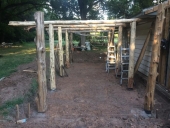
 1
1




 1
1




"Study books and observe nature; if they do not agree, throw away the books." ~ William A. Albrecht




 3
3




"Study books and observe nature; if they do not agree, throw away the books." ~ William A. Albrecht








"Study books and observe nature; if they do not agree, throw away the books." ~ William A. Albrecht




 1
1




"Study books and observe nature; if they do not agree, throw away the books." ~ William A. Albrecht




 1
1








Yve Leroy wrote:How much do you let the logs pass each other on the corners?


"Study books and observe nature; if they do not agree, throw away the books." ~ William A. Albrecht








"Study books and observe nature; if they do not agree, throw away the books." ~ William A. Albrecht








"Study books and observe nature; if they do not agree, throw away the books." ~ William A. Albrecht
 1
1




Yve Leroy wrote:





"Study books and observe nature; if they do not agree, throw away the books." ~ William A. Albrecht








"Study books and observe nature; if they do not agree, throw away the books." ~ William A. Albrecht









|
There's no place like 127.0.0.1. But I'll always remember this tiny ad:
Homestead Pigs Course
https://permies.com/wiki/365748/Homestead-Pigs
|





